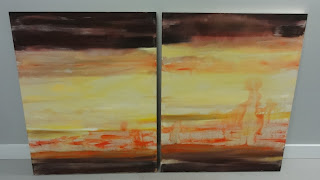Studio Progress (11/12/12)
Further work on 'Mood' acryic wash paintings, sellectively intensifying colour..Virginia Crit +
Discussed options for work:
- Painted as diptych, therefore many options for relationship / orientation of the two



- addition of grid / other major intervention - there would be no turning back.
New Work (reflecting on Traffic Lights Review)
- Increase in scale - possibility of using unstretched canvas straight from the roll
Problem of when to introduce grid:
1) On raw canvas- likely to inhibit mark making.
Painted on at the outset or masked out so that canvas remains. This would allow possibilty of taking some later washes over the whole piece.
2) After initial washes which would allow placing of grid in considered relationship with painting at this point.
Feel that appropriate grid should extend beyond the picture frame (Mondrian), rather than internalised grid (as much of Agnes Martin's work).
Consider 'homage to Mondrian',or at least covert reference! Lift one of his grids and use as an underpainting.......
Mondrian acheived his goal of producing pictures that were pure abstraction and his journey through ever increasing levels of abstraction is well documented. Reducing everything to 'the picture plane' and a palette of primary colours' or monochrome is too controlled for my current purposes.
The challenge may,perhaps, be summarised as:
- utilising a grid to imply activity beyond the confines of the canvas
- using free washes with a sensation of 'space' without tipping into the representation of an overtly 'landscape space'





























